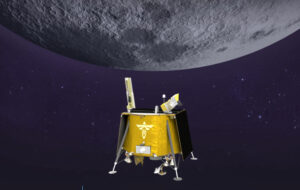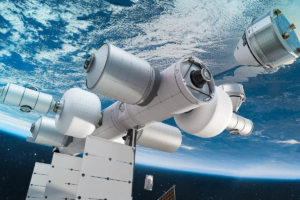
Dream Chaser Tenacity Progress & DC-201 Sneak Peek
Spaceplanes offer quite a few unique benefits if done correctly, While the Space Shuttle was by no means perfect, it helped create and launch a host of space infrastructure still in use today. This being said, spacecraft reusability is a complex process with more to consider than just getting the spacecraft back in one piece. A process that Sierra Space has been working on for decades.
Right now Sierra Space is completing some of the final preparations for the first launch of Dream Chaser Tenacity. Recent updates from the company highlight that the test article is on track to launch later this year for the first time. This comes in addition to a sneak peek released yesterday of a new dream chaser variant and design.
While the specific future of this spaceplane is unknown, we do know some of the goals that Sierra Space is working toward. Currently, the first goal is to successfully create and demonstrate the capabilities of an uncrewed Dream Chaser variant with launches to the International Space Station. Here I will go more in-depth into Dream Chaser Tenacity’s progress, the new dream chaser variant, what to expect in the future, and more.
New Dream Chaser Reveal

Starting off with some of the most exciting news, just yesterday Sierra Space tweeted saying, “Sierra Space’s Dream Chaser, Tenacity, is on track to become the first operational commercial spaceplane with a lifting body.” Included with this tweet was a render of two different Dream Chaser models. On the left is the uncrewed Dream Chaser variant which we know very well. However, on the right, you could see a new variant with a lot of differences from the standard spaceplane.
Current Dream Chaser test articles are labeled in the 100s. For example, Dream Chaser Tenacity is DC-101, and the second test article in the early stages of development is labeled DC-102. In the image, you can see this new variant is named DC-201. In terms of differences, the first and most obvious is size with DC-201 being a decent bit smaller. It also looks as if it features fixed wings on either side of the spaceplane. As we know, Dream Chaser has one set of folding wings toward the top of the spacecraft to allow the uncrewed version to fit within the payload fairings of various launch vehicles. The ability to fit into a payload fairing allows the cargo version to launch on any sufficiently capable vehicle, such as Ariane 5 as well as Vulcan, and more.
Another significant difference is the number of engines on the back. Here 8 engines can be seen with four on either side of the main access hatch. In contrast, based on different animations and reports from Sierra Space, Dream Chaser will utilize two Vortex engines at the back of the spacecraft. They will provide thrust after separation from the upper stage rocket, and control within low Earth orbit. This engine is built with low-cost and lightweight materials, making the company believe that Vortex may save tens of millions of dollars for each launch. This being said, it’s important to point out that like the Dream Chaser spaceplane itself, these engines have never actually flown. Over the past few months, we have been provided additional updates on the propulsion system and some of the tests it has completed. In general, the 8 engines on the DC-201 render look similar. It’s possible that these could be used for an abort capability on a future crewed version. On the other hand, Sierra Space has always been interested in having windows on a crew variant which the new render does not look to have.
Another difference is the layout of heat shield tiles on the spacecraft. One unique aspect of these tiles is their different colors depending on their location on the spacecraft. In this case, the white tiles reject more heat from the sun while on-orbit, which helps to keep the components within Dream Chaser cooler. The DC-201 variant features white on the top and black on the sides while the other Dream Chaser is the opposite. In the near future, we can expect Sierra Space to release more information on this system and what to expect in the future.
Future of Spaceplanes

Now that we know more about Sierra Space’s new Dream Chaser render and some of the differences it features, we can take a closer look at Tenacity’s progress toward its first launch. In yesterday’s tweet, Sierra Space commented that “Tenacity is on track to become the first operational commercial spaceplane with a lifting body.” One of the last specific updates we got on this test article was in November which included an image of Dream Chaser Tenacity with its heat shield tiles being installed.
By now in early January, this process should be coming to a close as work on this specific task has been going on for a few months now. Back in October the company tweeted mentioning, “Right now, our Dream Chaser team is hard at work affixing more than two thousand hand-cut thermal tiles. We’ll have more photos and close-ups of Tenacity coming soon.” Once this process is done, the team will work on some final testing and then should be ready for Dream Chaser’s first ever mission.
Unfortunately, while Dream Chaser Tenacity seems to be on schedule for a launch in the third quarter of this year, the launch vehicle Vulcan could be delayed. Vulcan’s maiden launch is set to happen in only a few months in the first quarter of this year. However, the launch vehicle is a few months behind at this point and has yet to be shipped to the Cape. Back in October ULA expected to ship the rocket in November and have completed a wet dress rehearsal and flight readiness firing by December. Neither has happened and it could push back this maiden flight. Ideally, this doesn’t affect Dream Chaser’s mission which will be the second ever launch of Vulcan, but it could depending on these initial results.
Focusing back on Dream Chaser and its two variants brings up more questions surrounding the new DC-201 option. Under NASA’s Commercial Resupply Services 2 (CRS-2) contract, Dream Chaser will provide a minimum of seven cargo service missions to and from the space station. While the uncrewed version is making the most current progress, a crewed variant is also important to the company. The originally planned Dream Chaser Space System was a human-rated version designed to carry from three to seven people and cargo to orbital destinations such as the International Space Station. It was to have a built-in launch escape system and could fly autonomously if needed. Although it could use any suitable launch vehicle, it was planned to be launched on a human-rated Atlas V N12 rocket. The vehicle will be able to return from space by gliding (typically experiencing less than 1.5 g on re-entry) and landing on any airport runway that handles commercial air traffic. Its reaction control system thrusters burned ethanol-based fuel, which is not an explosively volatile material, nor toxic like hydrazine, allowing the Dream Chaser to be handled immediately after landing, unlike the Space Shuttle.
The crewed version of Dream Chaser will be approximately 85% common to the cargo system, limiting primary changes to windows, environmental control, and life support systems. In addition, an integral main propulsion system is available for abort capability and major orbital maneuvers. Back in November 2021, Sierra Nevada Corporation reported that it received a $1.4 billion investment in Series A funding, which it will use to develop a crewed version of Dream Chaser and fly astronauts by 2025.
With the help of the Shooting Star™ service module, Dream Chaser can deliver up to 5,500 kg of pressurized and unpressurized cargo to the space station, including food, water, supplies, and science experiments before returning to Earth. Shooting Star also utilizes 6 RCS thrusters forming somewhat of a circle around the system. This adds additional capabilities and control within the space environment. After leaving the space station, the Dream Chaser Cargo System also offers disposal services via the Shooting Star transport vehicle. Once separated from Dream Chaser, Shooting Star burns up safely in Earth’s atmosphere.
The Dream Chaser spaceplane is a multi-mission vehicle capable of supporting a variety of LEO needs. It can be customized for both domestic and international customers via vehicle configuration, launch site, destination, landing site, duration, and a host of other variables. We have entered into agreements with multiple international space agencies. Together they are developing technologies, applications, and missions for Dream Chaser-based space systems. For a while now the company has also been making deals with spaceports and different companies around the globe to increase Dream Chaser’s portfolio of landing sites. Spaceport America, located in southern New Mexico, is the most recent addition to a growing list of compatible runways worldwide where the Dream Chaser could land, including the Shuttle Landing Facility (SLF) at NASA’s Kennedy Space Center and airports and landing sites in Huntsville, Alabama, Oita Airport, Japan, and Spaceport Cornwall in the United Kingdom.
Conclusion
Sierra Space is continuing to work on new and ambitious projects within the industry. Right now they are finishing work on Dream Chaser Tenacity in preparation for its first mission in the third quarter of this year. They also released a sneak peek of Dream Chaser 201, an exciting glimpse into what the company is working on. We will have to wait and see how it progresses and the impact it has on the space industry.



